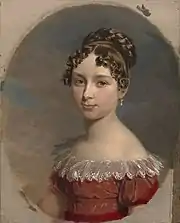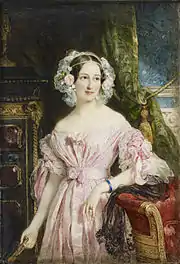Princess Feodora of Leiningen
Princess Feodora of Leiningen (Anna Feodora Auguste Charlotte Wilhelmine; 7 December 1807 – 23 September 1872) was the only daughter of Emich Carl, Prince of Leiningen (1763–1814), and Princess Victoria of Saxe-Coburg-Saalfeld (1786–1861). Feodora and her older brother Carl, 3rd Prince of Leiningen, were maternal half-siblings to Queen Victoria of Great Britain. She is a matrilineal ancestress (through women only) of Carl XVI Gustaf of Sweden and of Felipe VI of Spain.
| Princess Feodora | |||||
|---|---|---|---|---|---|
| Princess consort of Hohenlohe-Langenburg | |||||
_Jul_1859.jpg.webp) Princess Feodora in 1859. | |||||
| Born | 7 December 1807 Amorbach | ||||
| Died | 23 September 1872 (aged 64) Baden-Baden | ||||
| Spouse | |||||
| Issue | Carl Ludwig II, Prince of Hohenlohe-Langenburg Princess Elise Hermann, Prince of Hohenlohe-Langenburg Prince Victor Adelheid, Duchess of Schleswig-Holstein Feodora, Duchess of Saxe-Meiningen | ||||
| |||||
| House | Leiningen | ||||
| Father | Emich Carl, Prince of Leiningen | ||||
| Mother | Princess Victoria of Saxe-Coburg-Saalfeld | ||||
Life

Feodora was born in Amorbach, Bavaria, on 7 December 1807 to Princess Victoria of Saxe-Coburg-Saalfeld and her husband, Emich Carl, Prince of Leiningen. Her father died in 1814.
On 29 May 1818, her mother remarried to Prince Edward Augustus, Duke of Kent and Strathearn, the fourth son of King George III. The following year, when the duchess's pregnancy was reaching full term, the household moved so that the new potential heir to the British throne could be born in Britain.[1][2]
Feodora enjoyed a very close relationship with her younger half-sister Victoria, who was devoted to her, although Victoria resented the fact that Feodora was one of only a few other children with whom she was allowed regular interaction.[3][4] Despite their closeness, Feodora was eager to leave their residence at Kensington Palace permanently, as her "only happy time was driving out" with Victoria and her governess Baroness Louise Lehzen, when she could "speak and look as she liked".[3]
Marriage and later years

In early 1828, Feodora married Ernst I, Prince of Hohenlohe-Langenburg (1794–1860), at Kensington Palace. The match was arranged by Queen Adelaide of Great Britain, as Prince Ernst I was her first cousin. Prior to that, she had only met him twice.[5] After their honeymoon, she returned to the German Confederation, where she lived until her death in 1872.[3] The prince had no domain, however, as the principality had been mediatised to Württemberg in 1806. The couple lived in a large and uncomfortable castle, Schloss Langenburg.[3]
Feodora maintained a lifelong correspondence with her half-sister Victoria and was granted an allowance of £300 (equivalent to £25,995 in 2016) whenever she could visit Britain.[6] She was a member of the royal party at Victoria's coronation in 1838.[7]

Feodora's youngest daughter, the Duchess of Saxe-Meiningen, died in early 1872 of scarlet fever.[8] Feodora died later that year. On hearing of Feodora's death, Victoria wrote:[9]
"Can I write it? My own darling, only sister, my dear excellent, noble Feodore is no more! She is at rest & in peace since 2 this morning. What a fearful loss! Darling precious sister, whom I hoped so to go & see! The kind Empress Augusta telegraphed the news to me in a most feeling manner, & I got the telegram just after I came back from Abergeldie, where I had gone to see the preparations for Bertie's welcome. This was to have been & is still a day of rejoicing for all the good Balmoral people, on account of dear Bertie's first return after his illness, & I am here in sorrow & grief, unable to join in the welcome. God's will be done, but the loss to me is too dreadful! I stand so alone now, no near & dear one nearer my own age, or older, to whom I could look up to, left! All, all gone! How good & wise, beloved Feodore was, so devoted to me, so truly pious & religious. She is gone to that world she was so fit for & entered it, just sleeping away. What a blessed end! but what a loss to those who are left! She was my last near relative on an equality with me, the last link with my childhood & youth."
— Queen Victoria in her journal (23 September 1872)
Issue
Feodora and Ernest had six children (three sons and three daughters):
- Carl Ludwig II, Prince of Hohenlohe-Langenburg 25 October 1829 – 16 May 1907), succeeded his father on 12 April 1860, but abdicated his rights on 21 April to marry unequally. He married Maria Grathwohl on 22 February 1861. They had three children. His male issue has been created Princes of Weikersheim on 18. July 1911 by Emperor Franz Joseph.
- Princess Elise of Hohenlohe-Langenburg (8 November 1830 – 27 February 1850) died at the age of 19.
- Hermann, Prince of Hohenlohe-Langenburg (31 August 1832 – 9 March 1913) married Princess Leopoldine of Baden on 24 September 1862. They had three children.
- Prince Victor of Hohenlohe-Langenburg (11 December 1833 – 31 December 1891) married Lady Laura Seymour on 24 January 1861. They had four children.
- Princess Adelheid of Hohenlohe-Langenburg (20 July 1835 – 25 January 1900) married Frederick VIII, Duke of Schleswig-Holstein-Sonderburg-Augustenburg on 11 September 1856. They had five children.
- Princess Feodora of Hohenlohe-Langenburg (7 July 1839 – 10 February 1872) married George II, Duke of Saxe-Meiningen on 23 October 1858. They had three sons.
In media
In Victoria Series 3 (2019), Feodora is played by Kate Fleetwood. In the programme, Feodora is portrayed as a scheming, jealous sister who has fled Langenburg and refuses to return to her home, which is not historically accurate. Also, Feodora claims that King George IV (who was Victoria's paternal uncle and related to Feodora through her mother as a third cousin twice removed) wanted to marry her,[10] but there is no historical evidence for that.
Ancestry
| Ancestors of Princess Feodora of Leiningen | |||||||||||||||||||||||||||||||||||||||||||||||||||||||||||||||||||||||||||||||||||||||||||||||||||||||||||||||||||||||||||||||||||||||||||||||||||||||||||||||||||||||||||||||||||||||||||||||||||||||||||||||||||||||||||||||||||||||||||||||||||||||||||||||||||||||||||||||||||||||||
|---|---|---|---|---|---|---|---|---|---|---|---|---|---|---|---|---|---|---|---|---|---|---|---|---|---|---|---|---|---|---|---|---|---|---|---|---|---|---|---|---|---|---|---|---|---|---|---|---|---|---|---|---|---|---|---|---|---|---|---|---|---|---|---|---|---|---|---|---|---|---|---|---|---|---|---|---|---|---|---|---|---|---|---|---|---|---|---|---|---|---|---|---|---|---|---|---|---|---|---|---|---|---|---|---|---|---|---|---|---|---|---|---|---|---|---|---|---|---|---|---|---|---|---|---|---|---|---|---|---|---|---|---|---|---|---|---|---|---|---|---|---|---|---|---|---|---|---|---|---|---|---|---|---|---|---|---|---|---|---|---|---|---|---|---|---|---|---|---|---|---|---|---|---|---|---|---|---|---|---|---|---|---|---|---|---|---|---|---|---|---|---|---|---|---|---|---|---|---|---|---|---|---|---|---|---|---|---|---|---|---|---|---|---|---|---|---|---|---|---|---|---|---|---|---|---|---|---|---|---|---|---|---|---|---|---|---|---|---|---|---|---|---|---|---|---|---|---|---|---|---|---|---|---|---|---|---|---|---|---|---|---|---|---|---|---|---|---|---|---|---|---|---|---|---|---|---|---|---|---|---|---|
| |||||||||||||||||||||||||||||||||||||||||||||||||||||||||||||||||||||||||||||||||||||||||||||||||||||||||||||||||||||||||||||||||||||||||||||||||||||||||||||||||||||||||||||||||||||||||||||||||||||||||||||||||||||||||||||||||||||||||||||||||||||||||||||||||||||||||||||||||||||||||
References
Notes
- Hibbert 2000, pp. 9–10.
- Gill 2009, p. 34.
- Hibbert 2000, p. 22.
- Gill 2009, p. 51.
- Vallone 2001, p. 9.
- Hibbert 2000, p. 58.
- "Key to Mr Leslie's picture of Queen Victoria receiving the Holy Sacrament at her Coronation". National Portrait Gallery.
- Pakula 1997, p. 296.
- Queen Victoria (23 September 1872). "Journal Entry : Monday 23rd September 1872". queenvictoriasjournals.org. Retrieved 3 August 2019.
- A Coburg Quartet. Victoria Series 3, 2019. Retrieved Sept. 12 2019. https://www.imdb.com/title/tt9280054/reviews
Bibliography
- Albert, Harold A. (1967). Queen Victoria's sister: the life and letters of Princess Feodora. London: Hale.
- Gill, Gillian (2009). We Two: Victoria and Albert: Rulers, Partners, Rivals. New York: Ballatine Books. ISBN 0-345-52001-7.
- Hibbert, Christopher (2000). Queen Victoria: A Personal History. London: HarperCollins. ISBN 0-00-638843-4.
- Pakula, Hannah (1997). An Uncommon Woman: The Empress Frederick, Daughter of Queen Victoria, Wife of the Crown Prince of Prussia, Mother of Kaiser Wilhelm. New York: Simon and Schuster Inc. ISBN 0-684-84216-5.
- Vallone, Lynne (2001). Becoming Victoria. Yale University Press. ISBN 0-300-08950-3.
| Wikimedia Commons has media related to Princess Feodora of Leiningen. |